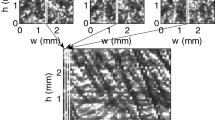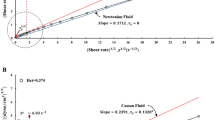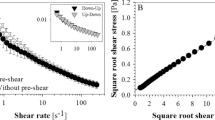Abstract
We investigate the shear thinning of red blood cell-dextran suspensions. Microscopic images show that at low polymer concentration, aggregation increases with increasing concentration until it reaches a maximum and then decreases again to non-aggregation. This bell-shape dependency is also deduced from the rheological measurements, if the data are correctly normalized by the viscosity of the suspending phase since a significant amount of polymers adsorb to the cell surfaces. We find that the position of the maximum of this shear rate-dependent bell shape increases with increasing viscosity of the suspending phase, which indicates that the dynamic process of aggregation and disaggregation is coupled via hydrodynamic interactions. This hydrodynamic coupling can be suppressed by characterizing a suspension of 80 % hematocrit which yields good agreement with the results from the microscopical images.







Similar content being viewed by others
References
Adamik K, Yozova I, Regenscheit M (2015) Controversies in the use of hydroxyethyl starch solutions in small animals emergency and critical care. Journal of Vetarinary Emergency and Critical care 25(1):20–47
Asakura S, Oosawa F (1954) On interaction between two bodies immersed in a solution of macromolecules. J Chem Phys 22:1255–1256
Baeumler H, Donath E (1987) Does dextran really significantly increase the surface potential of human red blood cells?. Stud Biophys 129:113–122
Baskurt O, Neu B, Meiselman H (2012) Red blood cell aggregation. CRC Press
Brooks D (1973) The effect of neutral polymers on the electrokinetic potential of cells and other charged particles: IV. Electrostatic effects in dextran mediated cellular interaction. J Colloid Interf Sci 43:714–726
Brust M, Aouane O, Thiébaud M, Flormann D, Verdier C, Kaestner L, Laschke MW, Selmi H, Benyoussef A, Podgorski T, Coupier G, Misbah C, Wagner C (2014) The plasma protein fibrinogen stabilizes clusters of red blood cells in microcapillary flows. Scientific Reports 4:4348
Chien S, Jan K (1973) Red cell aggregation by macromolecules: role of surface adsoprtion and electrostatic repulsion. J Supramol Str 1:385–409
Chien S, Usami S, Dellenback R, Gregersen M, Nanninga L, Guest M (1967) Blood viscosity: Influence of erythrocyte aggregation. Science 157:829–831
Evans E, Needham D (1988) Attraction between lipid bilayer membranes in concentrated solutions of nonadsorbing polymers: comarison of mean-field theory with measurements of adhesion energy. Macromolecules 21:1822–1831
Flormann D, Kuder E, Lipp P, Wagner C, Kaestner L (2015) Is there a role of C-reactive protein in red blood cell aggregation?. Int Jnl Lab Hem 37:474–482
Golstone J, Schoenbein H, Wells R (1970) The rheology of red blood cell aggregates. Microvasc Res 2:273–286
Jan K, Chien S (1973) Role of surface electric charge in red blood cell interaction. J Gen Physiol 61:638–654
Lambke L, Liljedahl S (1976) Plasma volume changes after infusion of various plasma expanders. Resuscitation 5:93–102
Lin N, Guy M, Hermes M, Ness C, Sun J, Poon W, Cohen I (2015) Hydrodynamic and contact contributions to shear thickening in colloidal suspensions. submitted
Maeda N (1983) Alteration of rheological properties of human erythrocytes by crosslinking of membrane proteins. Biochimica et Biophysica Acta 735:104–112
Maeda N, Seike M, Kume S, Takaku T, Shiga T (1987) Fibrinogen-induced erythrocyte aggregation: erythrocyte-binding site in the fibrinogen molecule. Biochim Biophys Acta 904:81–91
McCahon R, Hardman J (2006) Pharmacology of plasma expanders. Anaesthesia and intensive care medicine 8(2):79–81
Merill E, Gilland E, Lee T, Salzmann E (1966) Blood rheology: effect of fibrinogen deduced by addition. Circ Res 18:437–446
Neu B, Meiselman H (2002) Depletion-mediated red blood cell aggregation in polymer solutions. Biophys J 83:2482–2490
Steffen P, Verdier C, Wagner C (2013) Quantification of depletion-induced adhesion of red blood cells. Phys Rev Lett 110:018102
Wiedermann C (2014) Reporting bias in trials of volume resuscitation with hydroxyethyl starch. Wien klin Wochenschau 16:189– 194
Acknowledgments
The research leading to this result has received fundings from the German Research Foundation (DFG, SFB 1027), the Centre National de la Recherche Scientifique (CNRS), and the German French university (DFH/UFA).
Author information
Authors and Affiliations
Corresponding author
Additional information
This paper belongs to the special issue on the “Rheology of blood cells, capsules and vesicles”.
Rights and permissions
About this article
Cite this article
Flormann, D., Schirra, K., Podgorski, T. et al. On the rheology of red blood cell suspensions with different amounts of dextran: separating the effect of aggregation and increase in viscosity of the suspending phase. Rheol Acta 55, 477–483 (2016). https://doi.org/10.1007/s00397-015-0882-7
Received:
Revised:
Accepted:
Published:
Issue Date:
DOI: https://doi.org/10.1007/s00397-015-0882-7




